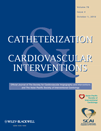Shunt reduction with a fenestrated Amplatzer device†
Conflict of interest: There is no conflict of interest associated with this manuscript for any author. Oliver Kretschmar, MD (on behalf of all authors).
Abstract
Background: In specific high-risk patients with congenital heart disease (CHD), a complete closure of an intracardiac defect/shunt is not possible for a variety of reasons. We report our experiences with an interventional approach for shunt-reduction using various modifications of a self-fabricated Amplatzer device in our institution. Methods: Retrospective analysis of patients with CHD having received an interventional partial shunt occlusion since 09/2005. Results: Five patients, mean age 18.6(3.4–66) years, mean weight 36.4(14–102) kg, have been treated. In three patients (3.4, 3.9, 66 years) with an atrial septal defect (ASD) and a restrictive left ventricle (LV) (n = 1) or pulmonary arterial hypertension (PAH) (n = 2), respectively, an Amplatzer Septal Occluder (ASO) with a predilated (n = 2) or a presutured (n = 1) central hole was implanted. After successful immediate volume release in all, the balloon-dilated holes closed spontaneously during mid-term follow-up, pulmonary artery (PA) pressure and LV function remained normal. Two patients (2.7 and 17 years) with a Fontan circulation and severe cyanosis (saturation ≤80%) due to a large fenestration and elevated PA pressures received a partial occlusion of their shunt by implanting a centrally stented ASO or Amplatzer Vascular plug. After a follow-up of 31 and 39 months both stents remained patent under oral anticoagulation, oxygen saturation remained >85% with PA pressures unchanged, and both patients were in good clinical conditions. Conclusions: In patients with an ASD and significant PAH and/or restrictive LV physiology as well as in Fontan patients with a large surgically created fenestration but failing Fontan circulation, a partial closure with a self-fenestrated Amplatzer device can be a feasible and successful therapeutic option. Balloon-dilated fenestrations in the Amplatzer device tend to close spontaneously during follow-up. Nonresorbable sutures or stenting can ensure patency of the created holes. © 2010 Wiley-Liss, Inc.




